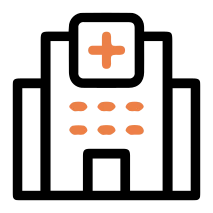Pneumonia in children is a serious respiratory infection that affects the lungs, leading to inflammation in the air sacs (alveoli). These sacs may fill with pus or fluid, making it difficult for the child to breathe and for oxygen to reach the bloodstream. It is a leading cause of illness and death in children under five, especially in developing countries. Yet, with prompt diagnosis and treatment, most children recover fully.
Childhood pneumonia can range from mild to severe and may be caused by a variety of microorganisms including bacteria, viruses, and fungi. The condition can be particularly dangerous in young children, especially those who are malnourished or have weakened immune systems. Despite advances in vaccines and antibiotics, pneumonia in kids continues to be a major public health challenge.
Understanding the signs, symptoms, and risk factors of pediatric pneumonia empowers parents and caregivers to act early. Early medical intervention can mean the difference between a quick recovery and a life-threatening emergency. Fortunately, most cases are treatable and preventable with vaccines, proper nutrition, and timely healthcare.
Causes of Pneumonia in Children
1. Viral Pneumonia
The most common cause of pneumonia in children, particularly under the age of five, is viruses. These include:
- Respiratory syncytial virus (RSV)
- Influenza virus
- Parainfluenza
- Adenovirus
- Coronavirus
Viral pneumonia often starts with symptoms similar to a cold but can escalate quickly to breathing difficulties.
2. Bacterial Pneumonia
This type tends to be more severe and sudden in onset. The most common bacterial agents include:
- Streptococcus pneumoniae
- Haemophilus influenzae type B (Hib)
- Staphylococcus aureus
Bacterial pneumonia is more likely to cause high fever, rapid breathing, and chest pain.
3. Fungal Pneumonia
Though rare, fungal pneumonia can affect immunocompromised children or those with chronic illnesses. It may result from exposure to soil-borne fungi like Histoplasma or Candida in hospitals.
4. Aspiration Pneumonia
This occurs when food, liquids, or vomit is inhaled into the lungs instead of being swallowed. It’s more common in children with swallowing disorders, neurological issues, or during episodes of vomiting.
Symptoms of Pneumonia in Children
Recognizing the symptoms of pneumonia in children is essential for early intervention. Symptoms may vary based on the child’s age, the cause of infection, and the severity.
Common symptoms include:
- Fever, often high in bacterial pneumonia
- Rapid or difficult breathing
- Wheezing or grunting sounds
- Cough—dry or productive
- Chest retractions (pulling in of skin between ribs while breathing)
- Loss of appetite
- Lethargy or extreme fatigue
- Bluish tint on lips or fingernails (cyanosis in severe cases)
Infants may present with vague symptoms like poor feeding, irritability, or vomiting, making diagnosis more challenging. In such cases, any abnormal breathing pattern should prompt immediate medical attention.
How Is Pneumonia in Children Diagnosed?
Diagnosis involves a combination of clinical evaluation and diagnostic tools. A pediatrician may suspect pneumonia based on symptoms and physical examination.
Diagnostic methods include:
- Chest X-ray: Helps identify lung infiltrates and differentiate between bacterial and viral types.
- Pulse oximetry: Measures oxygen levels in the blood.
- Complete blood count (CBC): Evaluates infection and inflammation markers.
- Sputum culture (for older children): Identifies the organism responsible.
- Blood cultures: Useful in detecting bacteria in severe cases.
Rapid diagnosis and classification of the type of pneumonia are crucial in guiding appropriate treatment.
Treatment of Pneumonia in Children
Treatment depends on the cause and severity of pneumonia.
1. Viral Pneumonia
- Supportive care: Rest, fluids, and fever control with paracetamol.
- Antiviral medications: In specific cases like influenza or COVID-19.
- Oxygen therapy: For children with difficulty breathing or low oxygen saturation.
2. Bacterial Pneumonia
- Antibiotics: Amoxicillin is commonly used for outpatient cases. Severe cases may require IV antibiotics like ceftriaxone or azithromycin.
- Hospitalization: Needed for severe cases, especially if the child is under two months, dehydrated, or struggling to breathe.
- Chest physiotherapy: Helps in clearing mucus, especially in recurrent or chronic cases.
3. Fungal and Aspiration Pneumonia
- Antifungal medications or specific antibiotics tailored to the suspected cause.
- Treatment of underlying conditions, like GERD or neuromuscular disorders.
Table: Viral vs. Bacterial Pneumonia in Children
| Feature | Viral Pneumonia | Bacterial Pneumonia |
|---|---|---|
| Onset of symptoms | Gradual | Sudden |
| Fever | Low-grade or absent | High, often above 102°F |
| Cough | Dry, persistent | Productive or with chest pain |
| Breathing difficulty | Moderate | Often severe |
| Chest X-ray findings | Diffuse infiltrates | Lobar consolidation |
| Treatment | Supportive care, antivirals in some cases | Antibiotics |
| Severity | Usually milder, self-limiting | Can be severe and life-threatening |
Prevention of Pneumonia in Children
Preventing childhood pneumonia involves a combination of immunization, hygiene, and nutrition.
1. Vaccinations
- Pneumococcal vaccine (PCV)
- Haemophilus influenzae type b (Hib) vaccine
- Influenza vaccine
- Measles and pertussis vaccines
These vaccines are proven to significantly reduce the incidence of pneumonia in children.
2. Good Nutrition
Well-nourished children have stronger immune systems and are better able to fight off infections. Breastfeeding also provides essential antibodies.
3. Hygiene Practices
Regular handwashing, avoiding crowded areas during flu season, and minimizing exposure to cigarette smoke help prevent respiratory infections.
When to Seek Emergency Help
Pneumonia in children can escalate quickly. Emergency care is necessary if a child shows:
- Labored or rapid breathing
- Bluish lips or fingernails
- Unresponsiveness or drowsiness
- Inability to eat or drink
- Convulsions or high-grade fever not responding to medication
Never delay medical care if you’re unsure—timely intervention can save lives.
Frequently Asked Questions (FAQs)
Is pneumonia in children contagious?
Yes, pneumonia, particularly viral pneumonia, can be contagious. Viruses like influenza or RSV that cause pneumonia spread through droplets when an infected person coughs or sneezes. Children can get infected by touching contaminated surfaces or through close contact with someone who is sick. Bacterial pneumonia is generally less contagious but can still spread under close quarters. Preventive measures such as vaccinations, good hand hygiene, and avoiding sick contacts play a critical role in reducing transmission. While the infection itself can be contagious, the actual diagnosis of pneumonia—particularly if bacterial—is not always spread directly from child to child.
What are the long-term effects of pneumonia in children?
In most cases, children recover completely from pneumonia with no lasting effects. However, complications can occur, especially in severe or untreated cases. These include lung abscesses, pleural effusion (fluid accumulation), and scarring of the lungs. In very young children, especially those with repeated episodes, pneumonia may affect lung growth or lead to chronic respiratory issues like asthma. Preterm infants or children with compromised immune systems are at higher risk of long-term consequences. Regular follow-ups and chest X-rays may be advised after recovery to ensure full resolution. With appropriate treatment and care, long-term damage is usually avoidable.
Can pneumonia be treated at home?
Yes, mild cases of pneumonia in children, especially viral pneumonia, can often be managed at home under pediatric supervision. Treatment includes adequate fluid intake, fever control, rest, and monitoring for warning signs. However, if the child is under two months, has high fever, breathing difficulty, persistent vomiting, or appears lethargic, hospitalization may be required. Antibiotics, if prescribed, should be completed as directed even if the child seems to improve. Always maintain close communication with your pediatrician and seek emergency help if symptoms worsen or do not improve within 48–72 hours.
Are antibiotics always needed for childhood pneumonia?
No, not all types of pneumonia require antibiotics. Viral pneumonia, which is quite common in children under five, does not respond to antibiotics. In such cases, supportive care is the mainstay of treatment. Antibiotics are essential in confirmed or suspected bacterial pneumonia, which tends to cause higher fever and more severe symptoms. Your doctor may start empirical antibiotics based on clinical findings while awaiting lab results. Misuse of antibiotics in viral cases can lead to resistance and side effects. Therefore, a proper diagnosis is crucial before starting any medication.
Can pneumonia cause seizures in children?
Yes, high fever associated with pneumonia can cause febrile seizures, especially in children between 6 months and 5 years. While febrile seizures are generally harmless and self-limiting, they can be frightening for parents. Pneumonia can also cause seizures if it leads to hypoxia (low oxygen levels in the brain), particularly in severe or untreated cases. If a child with pneumonia experiences a seizure, it is considered a medical emergency, and prompt evaluation is essential to rule out complications like meningitis or encephalitis.
What’s the difference between bronchitis and pneumonia in children?
Bronchitis is inflammation of the bronchial tubes, whereas pneumonia affects the air sacs in the lungs. Bronchitis usually causes a persistent, dry cough with mild fever and is often viral. It may not show changes on a chest X-ray. Pneumonia, on the other hand, presents with high fever, fast breathing, wet cough, and lung sounds like crackles. Chest X-rays usually confirm the diagnosis. Bronchitis is generally milder and self-resolving, while pneumonia may need antibiotics, hospitalization, or oxygen therapy. Distinguishing between the two helps in providing the right treatment.
Can a child get pneumonia more than once?
Yes, recurrent pneumonia in children can happen, especially if there are underlying conditions such as asthma, immune deficiencies, or anatomical abnormalities like tracheoesophageal fistula. While a single episode may not be alarming, repeated episodes—particularly in the same area of the lung—warrant further investigation. Doctors may recommend imaging studies, sweat chloride tests (for cystic fibrosis), or immunological assessments to identify the cause. With proper treatment and attention to the underlying cause, recurrent pneumonia can be managed effectively.
Is pneumonia preventable through vaccination?
Yes, vaccines play a major role in preventing pneumonia. The pneumococcal conjugate vaccine (PCV), Haemophilus influenzae type b (Hib) vaccine, influenza vaccine, and measles vaccine are all effective in reducing the incidence of pneumonia. These vaccines are part of most national immunization schedules and have significantly lowered pneumonia-related deaths. Additionally, breastfeeding, good nutrition, avoiding smoke exposure, and practicing hygiene further enhance a child’s defense against respiratory infections.
How long does it take for a child to recover from pneumonia?
The recovery time for pneumonia varies based on the child’s age, immune status, and the severity of the illness. Mild cases may resolve in 7–10 days with home care, while more severe cases can take up to 3–4 weeks for complete recovery. Some children may continue to have a lingering cough for several weeks. Follow-up with a pediatrician is essential to ensure the infection has fully resolved. In cases of complicated pneumonia, additional imaging and longer treatment courses may be necessary.
Can pneumonia in children lead to hospitalization?
Yes, children with moderate to severe pneumonia, especially those under two months or with pre-existing health conditions, may require hospital admission. Hospitalization is necessary for IV antibiotics, oxygen support, monitoring for complications, and ensuring hydration and nutrition. Signs like chest indrawing, rapid breathing, cyanosis, or inability to feed are indicators for hospital care. In developed countries, pneumonia is one of the most common reasons for pediatric hospitalization. Prompt treatment reduces the risk of long-term complications or death.
Research Articles on Pneumonia in Children
| Title | Author(s) |
|---|---|
| Global Burden of Pediatric Pneumonia: Epidemiology and Prevention | Dr. Michael Levin |
| Pneumonia in Under-Five Children: Risk Factors and Management | Dr. Swati Mehra |
| Bacterial vs. Viral Pneumonia in Children: Diagnostic Strategies | Dr. Emma Robinson |
| Role of Vaccination in Reducing Childhood Pneumonia | Dr. Neha Khosla |
| Pediatric Aspiration Pneumonia: Causes and Outcomes | Dr. John Osei |
| Management of Severe Pneumonia in Developing Countries | Dr. Maria Gomez |
| Recurrent Pneumonia in Children: A Clinical Review | Dr. Hitesh Arora |
| Antibiotic Resistance in Pediatric Respiratory Infections | Dr. Irene Muñoz |
| Respiratory Viral Infections in Pediatric Populations | Dr. Shalini Rao |
| Nutritional Interventions to Prevent Childhood Pneumonia | Dr. Andrew Lee |






 and then
and then